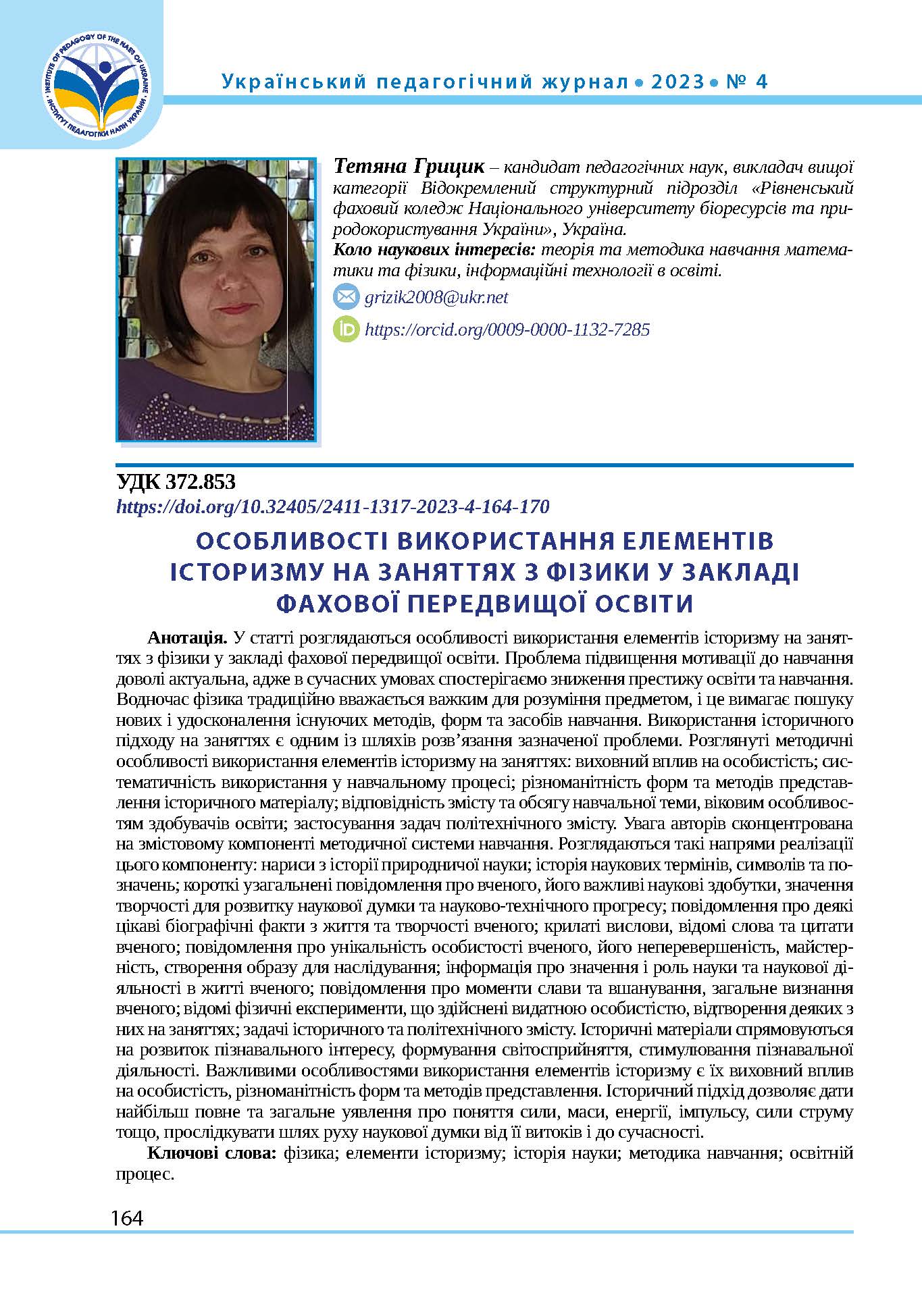Abstract
The article examines the peculiarities of the use of historicisms in physics classes at an institution of vocational pre-university education. The problem of increasing motivation to study is quite urgent, because in modern conditions we are observing a decline in the prestige of education and training. At the same time, physics is traditionally considered a difficult subject to understand, and this requires the search for new and improvement of existing methods, forms and means of learning. Using a historical approach in classes is one of the ways to solve the mentioned problem. The methodological features of the use of historicisms in classes are considered: educational influence on the personality; systematic use in the educational process; variety of forms and methods of presenting historical material; correspondence of the content and volume to the educational topic, age characteristics of the students of education; application of problems of polytechnic content. The authors' attention is focused on the content component of the methodical system of education. The following areas of implementation of this component are considered: essays on the history of science and the history of domestic science; history of scientific terms, symbols and designations; short generalized messages about the scientist, his/her important scientific achievements, the importance of creativity for the development of scientific thought and scientific and technological progress; information about some interesting biographical facts from the scientist's life and work; catchphrases, famous words and quotes of a scientist; a message about the uniqueness of the scientist's personality, his/her incomparability, skillfulness, creation of an image for imitation; information about the importance and role of science and scientific activity in the life of a scientist; information about moments of fame and honor, general recognition of a scientist; famous physical experiments carried out by an outstanding personality, reproduction of some of them in classes; problems of historical and polytechnic content. Historical materials are aimed at the development of cognitive interest, the formation of worldviews, and the stimulation of cognitive activity. Important features of the use of historicisms are their educational impact on the personality, variety of forms and methods of presentation. The historical approach allows us to give the most complete and general idea of the concepts of force, mass, energy, momentum, current strength, etc., to trace the path of movement of scientific thought from its origins to the present day.
References
Бар’яхтар, В.Г. (2019). Фізика. 11 клас. Рівень стандарту: підручник для загальноосвітніх навчальних закладів. Харків: Ранок.
Білецький, В.В. (2018). Методичні засади реалізації виховних функцій навчання фізики в коледжах економічного профілю. Дисертація кандидата педагогічних наук. Київ: Національна академія педагогічних наук України.
Головко, М. (2020). Становлення та розвиток теорії і методики навчання фізики в Україні: монографія. Київ: Педагогічна думка.
Заболотний, В.Ф., Слободянюк, І.Ю. (2015). Психолого-педагогічні аспекти вивчення фізики в класах гуманітарного профілю. Науковий часопис НПУ імені М.П.Драгоманова, 3 (16), 17‒22.
Корсун І.В. (2018). Внесок українських учених у розвиток оптики. Український фізичний журнал, 63 (10), 943‒953.
Шарамова, В. (2009). Українські фізики та астрономи. Посібник-довідник. Видання друге, доповнене. Тернопіль: Підручники і посібники.
Шут, М.І., Ільїн, В.О., Заболотний, В.Ф. (2015). Історія фізики: навчальний посібник Київ: Інститут обдарованої дитини.
Bariakhtar, V.H. (2019). Fizyka. 11 klas. Riven standartu: pidruchnyk dlia zahalnoosvitnikh navchalnykh zakladiv. Kharkiv: Ranok. (in Ukrainian).
Biletskyi, V.V. (2018). Metodychni zasady realizatsii vykhovnykh funktsii navchannia fizyky v koledzhakh ekonomichnoho profiliu. Dysertatsiia kandydata pedahohichnykh nauk. Kyiv: Natsionalna akademiia pedahohichnykh nauk Ukrainy. (in Ukrainian).
Holovko, M. (2020). Stanovlennia ta rozvytok teorii i metodyky navchannia fizyky v Ukraini: monohrafiia. Kyiv: Pedahohichna dumka. (in Ukrainian).
Zabolotnyi, V.F., Slobodianiuk, I.Iu. (2015). Psykholoho-pedahohichni aspekty vyvchennia fizyky v klasakh humanitarnoho profiliu. Naukovyi chasopys NPU imeni M.P.Drahomanova, 3 (16), 17‒22. (in Ukrainian).
Korsun I.V. (2018). Vnesok ukrainskykh uchenykh u rozvytok optyky. Ukrainskyi fizychnyi zhurnal, 63 (10), 943‒953. (in Ukrainian).
Sharamova, V. (2009). Ukrainski fizyky ta astronomy. Posibnyk-dovidnyk. Vydannia druhe, dopovnene. Ternopil: Pidruchnyky i posibnyky. (in Ukrainian).
Shut, M.I., Ilin, V.O., Zabolotnyi, V.F. (2015). Istoriia fizyky: navchalnyi posibnyk Kyiv: Instytut obdarovanoi dytyny. (in Ukrainian).

This work is licensed under a Creative Commons Attribution-NonCommercial-ShareAlike 4.0 International License.


